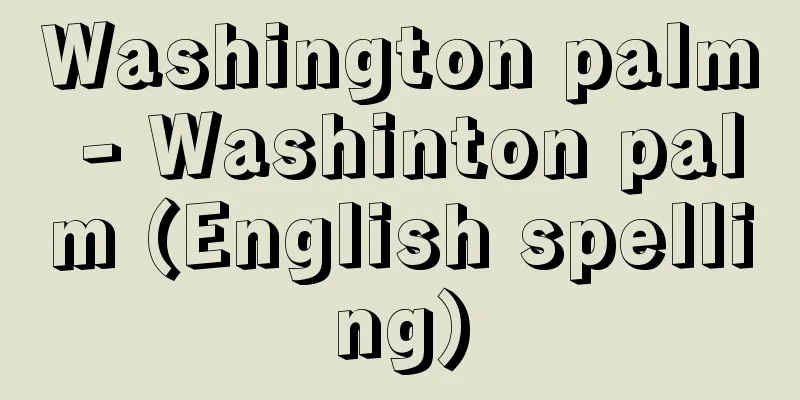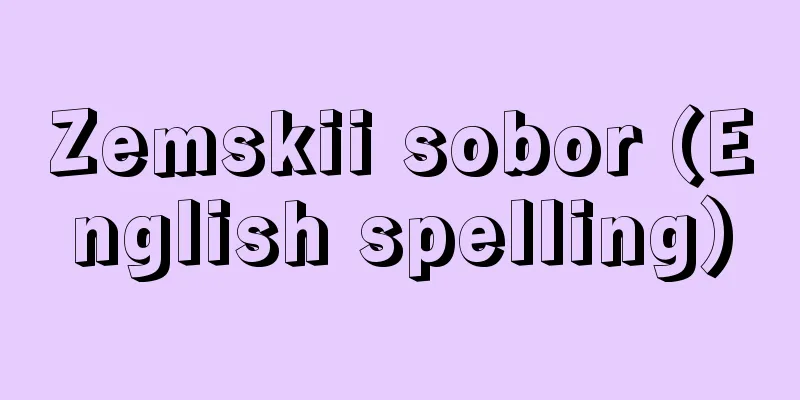Washington palm - Washinton palm (English spelling)

|
A general term for the genus W. filifera Wendl., a member of the Palmaceae family (APG classification: Palmaceae). Two species are found in North America and Mexico. There are many theories about the classification of this genus, and many species have the same or synonymous names, but LH Bailey limited the genus to two species: W. filifera Wendl. and W. filifera Wendl. The trunk is single and upright, 15-27 meters tall and cylindrical, but the stems below the petiole suddenly swell, reaching a diameter of 0.8-1 meter at the bottom and 0.3-0.8 meters at the top. The leaf sheaths at the base of the petiole are largely divided, and the dead leaves remain for a long time and hang down like a straw raincoat. When old leaves are cut, the reddish-brown stem bases intertwine in a bamboo basket shape. The leaves are dark or bright green, deeply lobed, palmate, 1-2 meters long. The lobes are lambda-shaped (inwardly inverted funnel-shaped), with long hair-like fibers hanging from the margins. The petiole is 1-2 meters long and has strong hook-shaped spines on both edges. This genus does not flower until the trunk reaches 6-7 meters in height. The spadix is 3-4 meters long. The bracts are slender and tubular, curved in an arch shape, and the whip-shaped pedicel hangs down, 20 centimeters long, and branched once or twice. The flowers are bisexual, but male flowers may also be present. They emit a foul odor, are 8-10 mm long, and the petals are pointed, tongue-shaped, 7 mm long, and 4 mm wide. There are six stamens, shield-shaped anthers 5 mm long, filaments 5 times larger than the pistils, which are 2 mm high, and a small stigma. The calyx is deep and cup-shaped. The fruit is black or dark brown, pointed and ovoid, 10 mm long and 8 mm wide, flat on one side and spherical on the other. The flesh is sweet. The seeds are similar to those of the Japanese quince, brown and smooth, 7 mm long and 5 mm wide, concave on one side and convex on the other. Sometimes two or three seeds form a cluster. The embryo is diagonally below the convex side. The Washington palm is native to North America, the Colorado Desert and Canyon, Arizona, and New Mexico. It is 15 meters tall and 1 meter in diameter. Its leaves are glossy gray-green, with 50-70 lobes and a diameter of 2 meters. It differs from the Washington palm in that the underside of the petiole tip, which is the leaf's central attachment point, becomes the central axis, extends 8-15 cm deep into the entire leaf, has veins at the end, and has long fibers at the tip. The upper half of the petiole is fleshy, semicircular in cross section with a raised back, and flattens at the bottom. The false Washington palm is native to western North America and the northern west coast of Mexico. It grows to a height of 22-27 meters, with rare species reaching 35 meters. Its leaves are glossy and bright green. The length of the petiole from the stem to the top of the leaflet is 1 meter, and the stem's stem attachment point is triangular and does not extend any further into the leaf. The cross section of the petiole is triangular, showing a striking contrast to the false Washington palm. It grows in humid areas, and can be cultivated at temperatures above -5°C. Most Washington palms in Japan are the false Washington palm. [Toshihiko Satake May 21, 2019] Source: Shogakukan Encyclopedia Nipponica About Encyclopedia Nipponica Information | Legend |
|
ヤシ科(APG分類:ヤシ科)コウリハ亜科ワシントンヤシ属の総称。北アメリカ、メキシコに2種分布する。本属の分類については雑多な説があり、多種の同種異名があったが、ベーレーL. H. Baileyは本属を、オキナワシントンヤシcalifornia washington palm/W. filifera Wendl.と、ワシントンヤシモドキmexican washington palmの2種に限定した。幹は単一で直立し、高さ15~27メートル、円柱状であるが、葉柄着生部以下が急に肥大し、下部径は0.8~1メートル、上部径は0.3~0.8メートル。葉柄基部の葉鞘(ようしょう)は大きく分裂し、枯葉は長期間残り蓑(みの)状に垂れる。古葉を切断すると赤褐色の葉柄基部が竹籠(かご)状に交錯する。葉は暗緑色または鮮緑色、深裂掌状葉で長さ1~2メートル。裂片はΛ(ラムダ)状(内向鑷合(じょうごう)状)で、縁辺に長い毛状繊維が垂れる。葉柄は1~2メートルで両縁に鉤(かぎ)状の強刺がある。本属は幹高が6~7メートルになるまでは開花しない。肉穂花序は長さ3~4メートル。包葉は細長い管状で弓弧状に湾曲し、鞭(むち)状の花柄が垂れ、花柄は長さ20センチメートルで、1、2回分岐する。花は両性花であるが、雄花の雑居もある。悪臭を放ち、長さ8~10ミリメートル、花弁は先のとがった舌状で長さ7ミリメートル、幅4ミリメートル。雄しべは6本、葯(やく)は盾状で長さ5ミリメートル、花糸は雌しべの5倍、雌しべは高さ2ミリメートル、柱頭は小さい。萼(がく)は深いコップ状。果実は黒色または黒褐色、先のとがった卵形で長さ10ミリメートル、幅8ミリメートル、片面は平坦(へいたん)で別の面は球面。果肉は甘い。種子はコウリバヤシに似ており、褐色で平滑、長さ7ミリメートル、幅5ミリメートル。片面は凹面で別の片面は凸面。2、3個の種子が固まってつくこともある。胚(はい)は凸面側の斜め下にある。 オキナワシントンヤシは北アメリカ、コロラド砂漠と峡谷、アリゾナ、ニュー・メキシコ原産。高さ15メートル、径1メートル。葉は光沢のある灰緑色、裂片は50~70枚、葉の径は2メートル。ワシントンヤシモドキとの相違点は、葉の枢着部である葉柄尖頭(せんとう)部の裏面が中軸になり、8~15センチメートル全葉の内部に深く食い込み、末端が葉脈化し、尖頭部には長い繊維がある。葉柄の上半部が多肉的で、横断面は半円形で背面が盛り上がり、下部になると扁平(へんぺい)化している。 ワシントンヤシモドキは北アメリカ西部、メキシコ西岸北部原産。高さ22~27メートルで、まれに35メートルのものもある。葉は光沢のある鮮緑色。葉の葉柄枢着部から小葉上端部までの葉柄の長さ1メートル、葉柄の枢着部は三角形でそれ以上葉中に食い込まない。葉柄の横断面が三角形など、オキナワシントンヤシと顕著な対照を示す。多湿地でも生育し、栽培温度は零下5℃以上。日本国内のワシントンヤシはほとんどがワシントンヤシモドキである。 [佐竹利彦 2019年5月21日] 出典 小学館 日本大百科全書(ニッポニカ)日本大百科全書(ニッポニカ)について 情報 | 凡例 |
Recommend
Personality assessment(test)
A general term for methods of measuring and diagno...
Puss in Boots - Puss in Boots (English)
A Perrault fairy tale written in prose. The mille...
Yukio Kasaya
Born August 17, 1943. A skier from Yoichi, Hokkaid...
Keane - Keane
…He grew up as an orphan, joined a troupe of trav...
Twenty-eight Mansions - Nijyuhasshuku
1. In ancient China, the equator and the moon were...
Tango [town] - Tango
An old town in Takeno District, occupying the nort...
plumbagin
… Many quinones are found in nature. Benzoquinone...
Ohno (Aichi) - Ohno
...A ceramics city located in the central west co...
Genbo - Genbo
A Hosso sect monk in the Nara period. His secular...
Tsukidate [town] - Tsukidate
An old town in Kurihara County, northern Miyagi Pr...
Gray partridge
…They are popular game birds. Among the partridge...
Vlado Perlemuter
1904‐2002 A French pianist of Polish origin. He st...
Oshimachi - Oshimachi
...In the case of shrines, it is also called tori...
Jürgen Kuczynski
Economist and economic historian of the former Ea...
Back headband - Back headband
...In the olden days, it was called matsukou or m...




![Yamuna [river] - Yamuna](/upload/images/67cd0fe197eb8.webp)




![Kokonoe [town] - Kokonoe](/upload/images/67cb92c8c1283.webp)